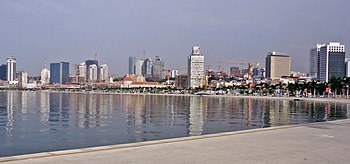
Back اقتصاد أنغولا Arabic Economía d'Angola AST Economia d'Angola Catalan Ekonomika Angoly Czech Wirtschaft Angolas German Economía de Angola Spanish Économie de l'Angola French Economía de Angola Galician Անգոլայի տնտեսություն Armenian Ekonomio di Angola IO
 | |
| Currency | Angolan kwanza (AOA, Kz) |
|---|---|
| Calendar year | |
Trade organisations | AU, AfCFTA (signed), African Development Bank, SADC, ECCAS, World Bank, IMF, WTO, Group of 77, OPEC |
Country group |
|
| Statistics | |
| Population | |
| GDP | |
| GDP rank | |
GDP growth |
|
GDP per capita | |
GDP per capita rank | |
GDP by sector |
|
| 11.75% (2023 est.)[4] | |
Population below poverty line | |
| 51.3 high (2018)[9] | |
Labour force | |
Labour force by occupation | |
| Unemployment | 6.6% (2016 est.)[6] |
Main industries | petroleum; diamonds, iron ore, phosphates, feldspar, bauxite, uranium, and gold; cement; basic metal products; fish processing; food processing, brewing, tobacco products, sugar; textiles; ship repair |
| External | |
| Exports | |
Export goods | crude oil, diamonds, refined petroleum products, coffee, sisal, fish and fish products, timber, cotton |
Main export partners |
|
| Imports | |
Import goods | machinery and electrical equipment, vehicles and spare parts; medicines, food, textiles, military goods |
Main import partners |
|
FDI stock | |
Gross external debt | |
| Public finances | |
| −6.7% (of GDP) (2017 est.)[6] | |
| Revenues | 26.1 billion (2023 est.) |
| Expenses | 23.98 billion (2023 est.) |
| Economic aid | $383.5 million (1999 est.) |
All values, unless otherwise stated, are in US dollars. | |

The economy of Angola remains heavily influenced by the effects of four decades of conflict in the last part of the 20th century, the war for independence from Portugal (1961–75) and the subsequent civil war (1975–2002). Poverty since 2002 is reduced over 50% and a third of the population relies on subsistence agriculture. Since 2002, when the 27-year civil war ended, government policy prioritized the repair and improvement of infrastructure and strengthening of political and social institutions. During the first decade of the 21st century, Angola's economy was one of the fastest-growing in the world,[18] with reported annual average GDP growth of 11.1 percent from 2001 to 2010.[19] High international oil prices and rising oil production contributed to strong economic growth, although with high inequality, at that time. 2022 trade surplus was $30 billion, compared to $48 billion in 2012.[20]
Corruption is rife throughout the economy[21][22] and the country remains heavily dependent on the oil sector, which in 2017 accounted for over 90 percent of exports by value and 64 percent of government revenue.[23] With the end of the oil boom, from 2015 Angola entered into a period of economic contraction.[24][25]
- ^ "World Economic Outlook Database, April 2019". IMF.org. International Monetary Fund. Retrieved September 29, 2019.
- ^ "World Bank Country and Lending Groups". datahelpdesk.worldbank.org. World Bank. Retrieved September 29, 2019.
- ^ "Population, total – Angola". data.worldbank.org. World Bank. Retrieved November 17, 2019.
- ^ a b c d e "World Economic Outlook Database, October 2022". IMF.org. International Monetary Fund. Retrieved October 12, 2022.
- ^ "Global Economic Prospects, June 2020". openknowledge.worldbank.org. World Bank: 105. June 8, 2020. Retrieved September 29, 2020.
- ^ a b c d e f g h i j "Angola". The World Factbook (2024 ed.). Central Intelligence Agency. Retrieved June 7, 2019. (Archived 2019 edition.)
- ^ "Poverty headcount ratio at national poverty lines (% of population)". data.worldbank.org. World Bank. Retrieved June 7, 2019.
- ^ "Poverty headcount ratio at $3.20 a day (2011 PPP) (% of population) – Angola". data.worldbank.org. World Bank. Retrieved March 22, 2020.
- ^ "GINI index (World Bank estimate) – Angola". data.worldbank.org. World Bank. Retrieved March 22, 2020.
- ^ "Human Development Index (HDI)". hdr.undp.org. HDRO (Human Development Report Office) United Nations Development Programme. Retrieved December 11, 2019.
- ^ "Inequality-adjusted HDI (IHDI)". hdr.undp.org. UNDP. Retrieved May 22, 2020.
- ^ "Labor force, total – Angola". data.worldbank.org. World Bank. Retrieved November 17, 2019.
- ^ "Employment to population ratio, 15+, total (%) (national estimate) – Angola". data.worldbank.org. World Bank. Retrieved November 17, 2019.
- ^ "Exports of goods and services (current US$) – Angola". data.worldbank.org. World Bank.
- ^ "Foreign export trade partners of Angola (2021)". The Observatory of Economic Complexity. Retrieved December 29, 2023.
- ^ "Imports of goods and services (current US$) – Angola". data.worldbank.org. World Bank.
- ^ "Foreign import trade partners of Angola (2021)". The Observatory of Economic Complexity. Retrieved December 29, 2023.
- ^ Birgitte Refslund Sørensen and Marc Vincent. Caught Between Borders: Response Strategies of the Internally Displaced, 2001. Page 17.
- ^ Graphic detail Charts, maps and infographics (January 6, 2011). "Daily chart: Africa's impressive growth". The Economist. Retrieved July 13, 2014.
- ^ Specter, Michael (May 2, 2015). "Luxury Living in a Failed State". The New Yorker. ISSN 0028-792X. Retrieved October 1, 2019.
- ^ "Angola Corruption Report". GAN Integrity. Retrieved October 1, 2019.
- ^ Isabel dos Santos made a fortune at the expense of the Angolan people, Luanda Leaks reveals. icij.org, published January 19, 2020
- ^ "Angola: Selected Issues". International Monetary Fund. April 2018. p. 6. Retrieved October 1, 2019.
- ^ Sieff, Kevin (August 2, 2016). "An oil boom made it the most expensive city in the world. Now it's in crisis". Washington Post. ISSN 0190-8286. Retrieved October 1, 2019.
- ^ Onishi, Norimitsu (June 2, 2017). "Angola's Corrupt Building Boom: 'Like Opening a Window and Throwing Out Money'". The New York Times. ISSN 0362-4331. Archived from the original on January 1, 2022. Retrieved October 1, 2019.
© MMXXIII Rich X Search. We shall prevail. All rights reserved. Rich X Search